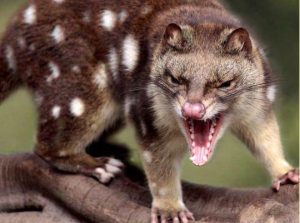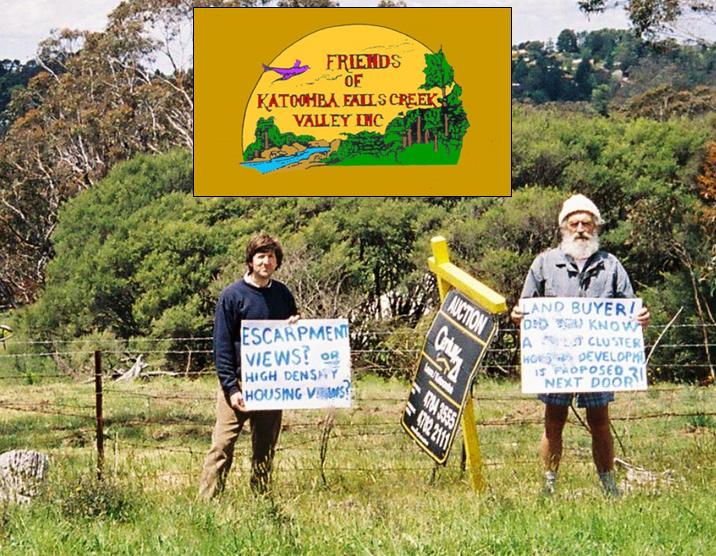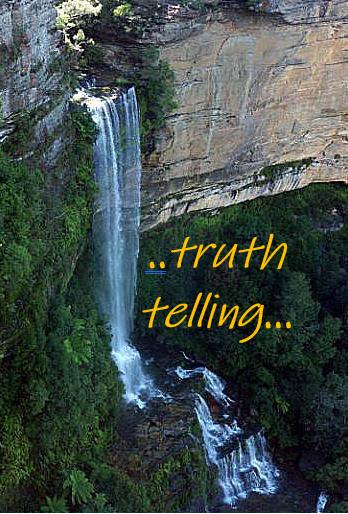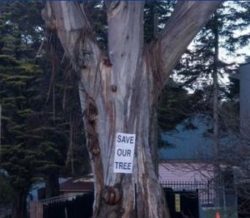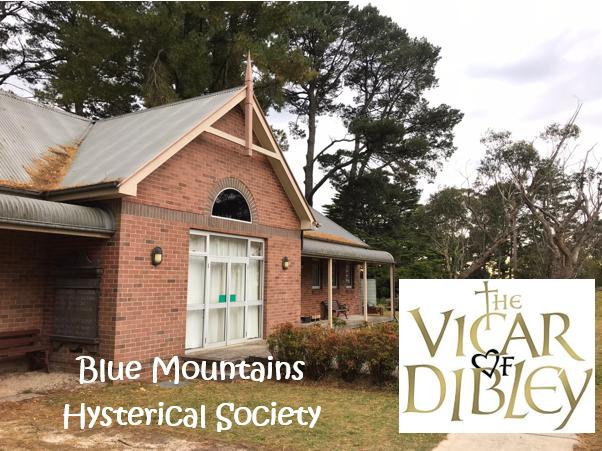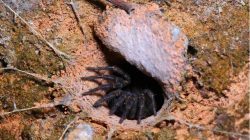Posts Tagged ‘kangaroo poaching’
Friday, June 15th, 2012
The following article was initially written by Tigerquoll entitled ‘175,000,000 Kangaroos Required to Support a Vicious Immoral Trade‘ and published on CanDoBetter.net 20100517.
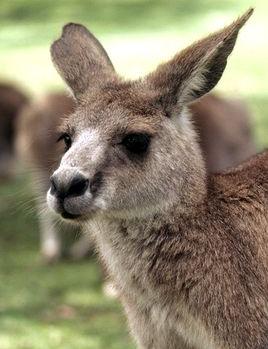
Some claim kangaroo meat is ‘green’. Some even claim killing kangaroos is ‘better’ for Australia’s environment.
So what if Australian farmers of lamb, beef, pork and chicken transitioned to kangaroo? To this author it is like employing mass murderer Ivan Milat to skin platypus for cheap token tourist purses.
Personal bias aside, Australia’s Federal Treasury Secretary, Ken Henry, has highlighted the flawed presumptions of Australia’s roo trade as unviable.
The following extracts are taken from Sydney Morning Herald’s Jacob Saulwick in his article ‘Henry doubts viability of roo harvesting’ of 13-Mar-10 (reproduced below):
.
“If we’re lucky, it will be many decades before we know whether these judgments are well based,” Dr Henry said of commercial kangaroo harvest quotas in December… “If they are, this will turn out to be the first instance in human history of the sustainable plunder of a natural resource.”
Dr Henry is at odds with prominent ecologists, as well as the economist Ross Garnaut. Professor Garnaut’s 2008 climate-change review made the case for an increased diet of roo displacing cattle and sheep consumption. The Garnaut report cited a study by George Wilson and Melanie Edwards that predicted a 3 per cent drop in greenhouse emissions if roo numbers rose from 25 million to 175 million, pushing cattle and sheep of rangelands, and displacing some red meat consumption.
Critics on the Henry side question the numbers, unconvinced kangaroo meat could ever replace red meat consumption in Australia to any significant degree.
“A lot of the environmental movement supports eating kangaroos, because people think it is green,” said Daniel Ramp, a biologist at the University of NSW helping set up a think tank on the roo industry with the Institute of Sustainable Futures at the University of Technology, Sydney.
“But we need to follow that argument through and ask how many sheep or cattle we could displace with meat from a kangaroo.”
On Dr Ramp’s figures, if every Australian were to start eating roo regularly, its population would need to swell from about 25 million well into the hundreds of millions and possibly billions.
Industry estimates put the average amount of meat derived from a single roo at 12 kilograms. If a 12-kilogram meat yield provides 48 people with one 250 gram meal, 24 million roos would be needed for everyone in Australia to have one meal a week.
But quotas prevent the industry harvesting more than 15 per cent of the roo population a year, making a population above 160 million necessary. Providing fillets would require many more roos, while maintaining the existing amount of meat that is used for pet-food could push the required population into the billions.
“Imagine if we had 175 million kangaroos running about?” said Dr Ramp. “The environmental degradation would potentially be large and it would not be safe to drive on rural roads for the sheer number of kangaroos.”
.
Standard roo shooter myths need to be debunked such as the false claims that ‘kangaroo meat is ‘green’, better for the environment and could replace farmed livestock outright.
- The ethics of killing wildlife still has not been justified by roo shooters.
- The ethics of the means of killing kangaroos and their joeys still has not been justified by roo shooters.
- The ethics of encouraging a wildlife export trade in kangaroo meat by Anna Bligh to Russia says a lot about Anna Bligh.
- The inherent risk of using kangaroo meat for human consumption still has not been justified by roo shooters.
- The lack of effective government controls associated with kangaroo killing continues to be ignored by state and federal governments.
.
Red Meat Consumption
.
The debate over whether we should reduce our consumption of meat is warranted, both from an ethical standpoint and an environmental one. If farmers were paid a decent kilogram price for traditional livestock that factored in the cost of land management and rehabilitation on downgraded farmland, the consumption would reduce as it would become unaffordable to most.
The first step is to make livestock (read ‘meat’ – beef, lamb) a gourmet food – high quality and high price – say $40/kg like fillet steak. Market forces would then reduce the demand. Livestock farmers would need to transition to other more sustainable industries (with government subsidy). The primary industry outcome would see a fraction of the current land being used for red meat production. It would be organic, grass feed/ free range, humane and profitable – but government restricted like the abalone industry.
The other strategy is to develop sustainable alternatives that offer natural nutritional equivalents – heam iron, protein, selenium (antioxidant) , zinc, omega-3 fatty acids, Vitamin D and B-group vitamins (riboflavin, niacin, pantothenic acid, vitamin B6 and in particular vitamin B12).
“But Vitamin B12 cannot be found in plant foods, therefore inadequate intakes of B12 are a problem for strict vegetarians. Lacking vitamin B12 can adversely affect neurological function including memory and concentration.” [Meat and Livestock Australia website]
.
Further Reading:
.
[1] ‘Henry doubts viability of roo harvesting’
[Source: ‘Henry doubts viability of roo harvesting’, by Jacob Saulwick, Sydney Morning Herald, 20100313, ^http://www.smh.com.au/environment/conservation/henry-doubts-viability-of-roo-harvesting-20100312-q46c.html]
.
‘Eating kangaroo meat is, by all accounts, much better for the environment than dining on pork, lamb or beef. The natives emit negligible methane, tread lightly and without contributing to erosion, and have no need for vast quantities of feed intensively farmed elsewhere.
Then why is the Treasury Secretary, Ken Henry, ardent conservationist, flashing warning signs about the country’s $250 million roo industry?
Twice in the past six months he has highlighted concerns about kangaroo harvesting in his public speeches. And the issue he raised was not the animal welfare charge most commonly levelled – joeys are killed by a blow to the head – but whether the harvesting of roos is viable.
“If we’re lucky, it will be many decades before we know whether these judgments are well based,” Dr Henry said of commercial kangaroo harvest quotas in December.
“If they are, this will turn out to be the first instance in human history of the sustainable plunder of a natural resource.”
Dr Henry is at odds with prominent ecologists, as well as the economist Ross Garnaut. Professor Garnaut’s 2008 climate-change review made the case for an increased diet of roo displacing cattle and sheep consumption. The Garnaut report cited a study by George Wilson and Melanie Edwards that predicted a 3 per cent drop in greenhouse emissions if roo numbers rose from 25 million to 175 million, pushing cattle and sheep off rangelands, and displacing some red meat consumption. Critics on the Henry side question the numbers, unconvinced kangaroo meat could ever replace red meat consumption in Australia to any significant degree.
“A lot of the environmental movement supports eating kangaroos, because people think it is green,” said Daniel Ramp, a biologist at the University of NSW helping set up a think tank on the roo industry with the Institute of Sustainable Futures at the University of Technology, Sydney.
“But we need to follow that argument through and ask how many sheep or cattle we could displace with meat from a kangaroo.”
On Dr Ramp’s figures, if every Australian were to start eating roo regularly, its population would need to swell from about 25 million well into the hundreds of millions and possibly billions.
Industry estimates put the average amount of meat derived from a single roo at 12 kilograms. If a 12-kilogram meat yield provides 48 people with one 250 gram meal, 24 million roos would be needed for everyone in Australia to have one meal a week. But quotas prevent the industry harvesting more than 15 per cent of the roo population a year, making a population above 160 million necessary. Providing fillets would require many more roos, while maintaining the existing amount of meat that is used for pet-food could push the required population into the billions.
“Imagine if we had 175 million kangaroos running about?” said Dr Ramp. “The environmental degradation would potentially be large and it would not be safe to drive on rural roads for the sheer number of kangaroos.”
.
Thursday, December 22nd, 2011
This article was initially published by Tigerquoll on Candobetter.net on 20090625 under the title ‘Shooters Party – fanatical red necks pushing for open season in National Parks’.
.
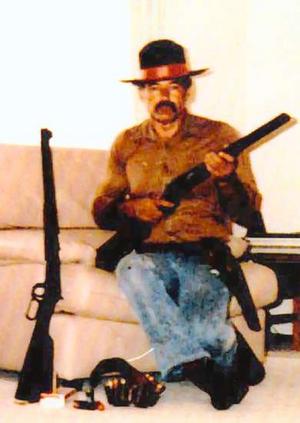 An infamous licensed shooter
An infamous licensed shooter
.
Since May 2009, Robert Brown MP of the Shooters Party has been pushing for the Game and Feral Animal Control Amendment Bill 2009 to be passed into legislation in New South Wales, Australia. The spin of this Bill is so feral animals can be controlled in National Parks. But in reality the proposed changes would mean the following main changes:
.
- Many of Australia’s native fauna across NSW would be condemned as ‘game animals’ just like in colonial times, when Australian native animals were despised as ‘vermin’. Other native animals can be included in the shooters hit list so long as there is consultation with the Minister for National Parks (DECC).
- It would be lawful for sporting shooters to hunt and shoot native fauna in all National Parks, State Forests, Crown Land and ‘private game reserves’ across NSW. Killing wildlife is to be branded as ‘conservation hunting’ and basically would be permissible through most natural landscapes outside built up areas.
- The Game Council of NSW, which is a government body dominated by members of shooting and hunting clubs, and it would assume authority for granting shooting licences in National Parks.
- Shooters and hunters in National Parks would be immune from protesters trying to protect native animals and birds – as it would become “an offence to approach persons (within 10 metres) who are lawfully hunting on declared public hunting land, or to interfere with persons lawfully hunting game animals”.
- Any environmental protection legislation that impedes shooting and hunting of native animals is to be overriden by the new changes – such as under the National Parks and Wildlife Act 1974.
- Hunting of native game animals can be done by non-commercial shooters – i.e weekend sports shooters. Using spot lights is optional and it is ok to leave the dead, dying and injured prey where they fall.
- In the case of native waterfowl, licensed game hunters will be required to pass an official identification test of native waterfowl. The record of shooters killing protected bird species is woeful, yet the proposed legislation won’t make any difference.
.
(Source: New South Wales Legislative Council, Game and Feral Animal Control Amendment Bill 2009, Second Reading in Parliament)
.
Professional safari hunters, recreational hunters, sports shooters, or weekend warriors?
.
This Bill would overturn all environmental legislation protecting our remaining wildlife in NSW. It is repugnant. This proposal is nothing to do with noble gesture of taking on the task of the government’s culling feral animals in National Parks.
.
The Game Council in this self-interested set of demands, simply wants to give its weekend warrior member base open slather access to shoot almost anything and everything in the bush. It would be 24/7 open season on wildlife perpetually across NSW every day of the year. Every weekend would be weekend warrior party time in the ute with the spotties and the beers and the guns – just like in the good old days eh? In doing so, The Game Council and the Shooters Party have shown their true colours. The Game Council’s objective is to provide for the effective management of ‘introduced species’ of game animals. By advocating the hunting and shooting of native animals and birds is outside its ‘introduced species’ charter.
.
According to Greens MP Ian Cohen, if feral animals are to be culled then:
“it should be managed by trained Livestock Health and Protection Authority officers.” “Recreational hunters are not helping when it comes to feral species – the reality is that hunters, with their dogs, are often a cause of pest species dispersal, driving feral animals into national parks.”
.
Fortunately, NSW Cabinet yesterday backed away from supporting the Bill.
‘Ivan Milat was a licensed competition shooter. In police interviews he referred to a shooting range in the Belangalo State Forest he knew well.‘
.
(Source: ^http://www.abc.net.au/austory/content/2004/s1239470.htm)
.
Milat was probably a member of a local shooting club, perhaps the Bowral Pistol Club situated in the Belangalo State Forest or with the Southern Highlands Rifle Club. As such, Milat would have been eligible to have been one of the licensed shooters/hunters under this Bill before being convicted of his crimes. This example of a licensed competition shooter does not engender public confidence in the shooting and hunting fraternity to be trusted to self-regulate itself and attract law abiding citizens and carte blache access to National Parks for shooting!
Message:
Exclude all native animals as ‘game’ and prohibit the use of dogs in all hunting and shooting and you will have me starting to listen to proposals by The Shooters Party to control feral animals. But as for controlling feral animals in National Parks in NSW, this is an ecological management matter for DECC to be held accountable for.
To be genuine about feral control, this Bill must specifically exclude:
- Native animals
- National Parks
- Recreational shooters
.
The intent then of The Shooters Party to help control ferals will starts becoming more genuine.
- If the Bill is one of targeting ferals, why does it include native animals in National Parks?
- If the Bill is one of targeting ferals, why is it limited to shooting and not other control means?
- Why are the government authorities most qualified to control feral animals not granted the delegated responsibility for this Bill?
- Where in this Bill does it specify controls on the time of day that shooting can take place? (i.e. it is 24/7)
- Where in this Bill does it specify how shooting is to be independently policed? It doesn’t.
- Where in this Bill does it specify that only qualified marksman trained in species identification will be permitted to engage in feral hunting in national parks? Why are recreational hunters permitted without the high standards of marksmanship and species recognition training?
- Where in the Bill are inexperienced recreational hunters prohibited from such shooting? These are the ‘weekend warriors’ that give the contract professionals a bad name, yet the The Game Council is not going out of its way to distinguish these two extremes.
- Who will be monitor, police and breath test the shooters?
- Who will watchdog those monitoring the shooters to ensure that all legal, environmental and ethical standards are properly complied with?
.
Under The (NSW) Fireams Act 1996 Part 2, Division 1, Clause 10 ‘Applications for Licences, all that is required to be granted a firearms licence is:
- Be over 18
- Show proof of ID
- Be someone who has not been convicted of an offence within the past 10 years
- Not subject to an apprehended violence order
- Not subject to a good behaviour bond
- Not deemed not a risk to public safety
- Pay the license fee.
.
Convicted backbacker murderer, Ivan Milat, was a legally licenced shooter and got through these stringent ‘elite’ tests and he owned multiple longarm firearms.
How does this reflect upon the test standards for firearm owners?
Since 18 August 2008, the Firearms Amendment Act 2008 has required unlicenced persons seeking a licence for longarms undertake and pass an approved Firearms Safety Qualification (Long-arms) Course. This is admittedly a step in the right direction.
.
(Source: NSW Shooting Centre)
.
Lack of professional controls for shooters
.
Under Firearms Regulation 2006 (NSW) clause 28 ‘Recreational hunting/vermin control—persons who are not members of approved hunting clubs’, an applicant can obtain a firearm licence without being a member of an approved hunting club in order to engage in recreational hunting/vermin control so long as they obtain and hold written proof of permission to shoot on rural land by the landholder which must describe the land to which the permission relates and the type of game to be shot.
But there is nothing in the legislation to enable a firearm holder to have a licence suspended or revoked as a result of shooting protected wildlife.
The NSW Department of Environment and Conservation, not the Game Council should be the prescribed authority for all vertebrate pest animal control.
.
Poor Species identification training
.
It is quite obvious that a feral animal is not synonymous with a native animal. One would hope that a shooter can distinguish a rabbit from a wombat, but what training exists to ensure natives are not mistakenly shot. Where is the policing to ensure that natives are not shot intentionally?
.
‘Conservation Hunters’?
.
Surely, this conjured term is oxymoronic spin. Instead, the designation ‘professional contract shooter‘ needs to be distinguished from ‘recreational shooter‘. If this Bill is to genuinely seek a professional approach to feral animal control it must specifically exclude recreational shooters and the weekend warrior element.
.
‘Ancestral & cultural right to hunt’?
.
The loose premise of some “ancestral & cultural right to hunt” – may apply to traditional Aborigines using traditional methods on traditional lands away from populated areas, but to quote the Game Council’s NSW Hunter eduication Handbook.. “in today’s world, hunting is no longer a necessity for most of us, but is something we are never the less driven to the associations with our past.” (p4.1.5). So this rather dubious argument says hunting is justified by some nostalgic notion of being connected to early colonists.
Airguns to teens are a catalysts for psychopaths. The book ‘Sins of the Brother: The Definitive Story of Ivan Milat and the Backpacker Murders‘ is an eye opener into a case of a hard rural lifestyle controlled by hardline paternal corporal punishment, when guns are part of life and temper tolerated.
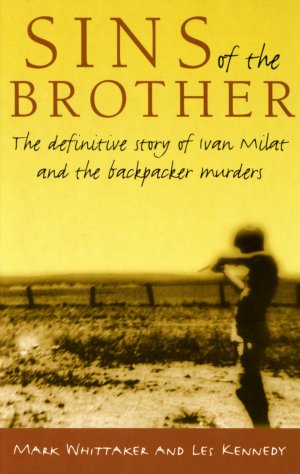 Publisher: ^http://www.panmacmillan.com.au/ Publisher: ^http://www.panmacmillan.com.au/
.
“Guns are power” as confirmed by Ivan Milat’s brother Boris. Untempered power leads to consequences only limited to the discretion of the person in control.
Gun laws in Australia fuel criminal opportunity, yet gun laws don’t test for criminality. A cocktail of a gun acceptance culture, killing of animals from an early age, an insular rural upbringing, a penchant for control, an uncontrolled aggression, and opportunity are a recipe for incubating deviancy and how Ivan Milats and Martin Bryants are made. Milat’s upbringing featured a tolerance of incest, which fueled sexual depravity.
.
It starts with children being given airguns (or similar). Airguns inculcate shooting living things as acceptable.
.
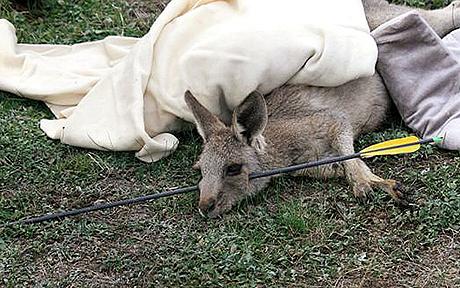 Kangaroo survives arrow shot through head Kangaroo survives arrow shot through head
Melbourne (2009):
‘A kangaroo survived for about a week after being shot through the head with an arrow, wildlife officials said, and is expected to make a full recovery. Wildlife Australia has posted a A$10,000 dollar (£5,032) reward to find the person responsible for shooting the kangaroo, which was found in parkland near Melbourne’s outer suburbs on Thursday.
Veterinary surgeons from Melbourne Zoo operated on the stricken animal over the weekend and were optimistic about his chances.
“This was a big injury, but because the arrow didn’t seem to have been in there for a long time, and the injury was fresh, hopefully he’ll be okay,” said Michael Lynch, a vet at Melbourne Zoo.
“I’m cautiously optimistic about the kangaroo’s prospects for a full recovery.”
The marsupial was rescued just days after another kangaroo was found with an arrow in its rump in the same location, said Fiona Corke, a Wildlife Victoria spokesman. She said her organisation wanted to catch those responsible.
“It’s just unbelievable, I just can’t believe that anybody would do something so cruel. It must be a very cold-hearted person to do that,” she told national news agency AAP.
Miss Corke said the kangaroo was believed to have survived for up to a week before it was discovered and taken to an animal hospital.
.
(Source: ‘Kangaroo survives arrow shot through head‘, Telegraph (UK), 20090511, ^http://www.telegraph.co.uk/news/worldnews/australiaandthepacific/australia/5309242/Kangaroo-survives-arrow-shot-through-head.html)
Tags: air gun, air rifle, animal cruelty, bb gun, hillbilly, Ivan Milat, kangaroo poaching, Martin Bryant, pellet gun, Shooters Party, slug gun, Wildlife
Posted in Kangaroos and Macropods, Threats from Poaching and Poisoning | 1 Comment »
Add this post to Del.icio.us - Digg
Tuesday, October 25th, 2011
This article was initially published by Tigerquoll onCanDoBetter.net on 20090524:
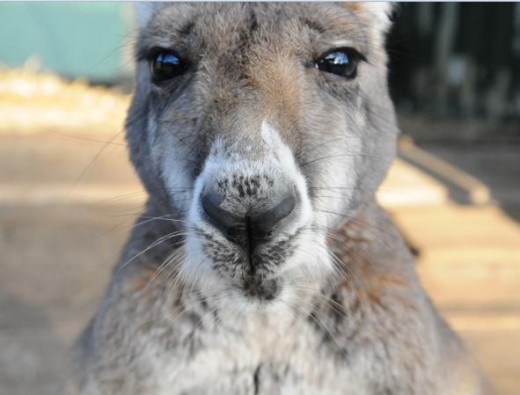 Australia’s native kangaroo – targeted by poachers and mass slaughter encouraged by Australian governments
Australia’s native kangaroo – targeted by poachers and mass slaughter encouraged by Australian governments
.
The Australian outback town of Mitchell lies in the Western Downs region of southern Queensland on the Warrego Highway just shy of 600 km west of Brisbane on the way to Charleville. Situated on the Maranoa River, the town of Mitchell was named in honour of the 19th Century explorer, and the town emerged as a pastoral town out of the farming of grains, beef and sheep. Tourism has become a strong drawcard to Mitchell and especially to its Great Artesian Spa.
But more recently, Mitchell’s fame has been lowered to infamy with it taking on a reputation for becoming the home of the kangaroo slaughter trade.
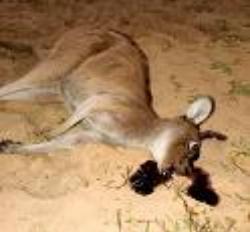 . .
“You see a lot of utes in Mitchell and the towns just like it that emerge from the roadside only to disappear again as you drive west through southern Queensland on the Warrego Highway. You can tell the ones that are driven by kangaroo shooters. They have racks for guns and long spikes upon which the freshly eviscerated carcasses are placed. One, parked just around the corner, has black steel bullbars with the words “roo raper” cut into them.”
.
‘Besides the slaughter of Australia’s iconic kangaroos for pet meat and indeed export for human consumption in fancy restaurant,
it is the sanitary conditions that is shocking and a life threatening time bomb’
.
Following the international biolab standards of Silliker, animal liberation chief, Mark Pearson says “the last time we did swabs here and in Charleville, they were alarmingly high in E.coli.“
‘The chiller doors aren’t locked. When Ben-Ami opens the first, problems are immediately apparent. Bright drips from fresh kills are spotting onto another layer of older, duller, deader blood, which is particularly thick nearest the front. The lip of the door frame is so thick and sticky, the red’s turned a dull, dark brown. Hairs are stuck to it.
.
‘The carcasses are packed as tightly as possible.
They hang from hooks by their legs,
their heads and tails missing,
gaping rents where their stomachs once were,
leg muscles tensed visibly;
severed necks poke into gut cavities;
hundreds of paws hang in a grisly reach towards the bloody floor.
According to their tags,
they’re four days dead.’
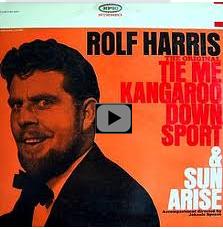
“These are quite young ones, heads cut off quite low,” Pearson says, pointing to a nub of spine that’s jutting out just above the shoulder.
“Most of them are cut too far back.” To decapitate in this way requires significantly more effort than using the traditional method, with a slice directly beloiw the jawline. It also makes bad financial sense to remove most of the neck , as harvesters are paid by weight. Proof, claim the activists, that an illegal shot in the jaw or neck has been covered up.
‘Pearson points to the floor. “They’re bringing in new carcasses and hanging them above the floor, which has blood from old carcasses. Blood is a Petri dish for disease and contamination. This is a major breach of any export abattoir standards.” he points to a small grey kangaroo that is caked elbow to paw in blood and dirt. “That’s from the evisceration,” he says. That’s all supposed to fall to the ground. And don’t forget, these would have been on the back [of a ute] for four, five, six hours, and it would have been 20 degrees. When you consider this is export meat…Uh-oh…”
Besides Mitchell, the roo rapers store their roo chillers at Charleville, Augathella and Blackall. The practice in outback Queensland is widespread.
To struggling towns in the outback like Mitchell, kangaroo meat is big business. “The Kangaroo Industry Industry Association of Australia says theirs is a business worth $270 million a year that directly employs about 4000 people” many in remote areas.”
[Source: Sydney Morning Herald, Good Weekend magazine, 20090523]
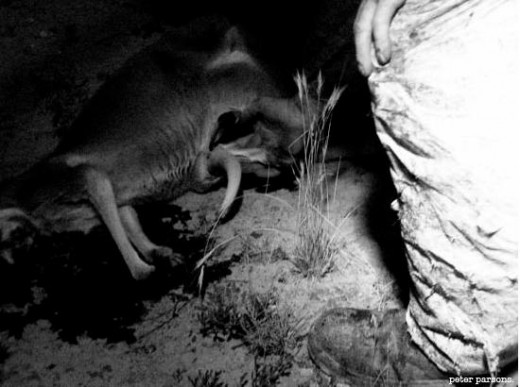
.
AusHunt, a website dedicated to hunting in Australia and it’s hunters, advocates:
.
“Kangaroo shooting is a unique job and many people are involved in one way or another in Australia’s kangaroo industry. My advice for the wannabe ‘roo shooter? You’ll need to make a few phone calls to chiller-box operators in various rural centers to evaluate the impact another ‘roo shooter would have there. Then decide on a location.
Before doing anything, take a week off work and go out with a qualified, professional ‘roo shooter and see what is actually involved.
Australia’s kangaroo industry is one of the only jobs in the world where a person can legally shoot wild animals full-time for a living.
Kangaroo shooting is a tough life with long hours, and a certain danger element. Depending on weather conditions (wind, rain), phases of the moon and drought, the kangaroo shooter may have a good or bad night. It can be a very irregular income earner.
Many shooters struggle to make money, some make a living, and a few make good profits of A$100,000/annum +. Dedication is the name of the game …. going out night after night and avoiding the temptations of the local pub. The upside is that the shooter is very independent and can lead an exciting outdoors life, totally using his wits, determination and shooting prowess to make money.
Okay, you like what you see and you’ve done your courses. Move to the rural center that you have selected and get a day job there, whether it be pumping gas or whatever. Then, start looking around for properties on which to shoot and start off by shooting week-ends. See how you go, then move on to fulltime when you know that you can make money. Good luck!”
.
.
‘Kangaroo harvesting under the spotlight’
.
Animal welfare activists are hoping public outrage over the slaughter of cattle in Indonesia can be redirected towards a new target – the commercial harvest of kangaroos. But activists’ involvement with research at the University of Technology, Sydney (UTS), has sparked a major scientific blue.
A year ago, animal welfare group Voiceless established THINKK at UTS, specifically to oppose the commercial kangaroo harvest. The unit’s lead scientist, ecologist Dr Dror Ben-Ami, says a lot of information about the kangaroo industry is misrepresented and not researched thoroughly.
This year, the national quota for the commercial harvest of kangaroos is set at around 3.7 million animals, but Dr Ben-Ami fears the real toll may be much higher.
“We estimate that up to a million dependent young are killed inhumanely every year as a result of the kangaroo industry,” he said.
“Those numbers come from industry statistics, in the sense of how many females are killed every year, and from behavioural reproductive ecology knowledge about how many young each female will have.”
There are in fact no industry figures on how many joeys are killed. Their main protection is the commercial shooters licence, which bans the hunting of females with dependent young.
Professor Mike Archer, the dean of science at the University of New South Wales (UNSW), says shooters are aware female kangaroos may be carrying joeys.
“There is an effort made by the shooters. They’re aware of this issue,” he said. He has raised questions about the research being done by THINKK.
“If a group like that were actually based in my university, in the University of New South Wales, we would be having a very serious think about whether they actually belong there,” he said.
“If they publish their own papers, refereed their papers themselves, didn’t quote real experts in the field, we would be very uncomfortable if they were operating in UNSW.”
.
Hygiene fears
.
Adult kangaroos are shot by night and driven to chillers the next day for processing, leading to another of THINKK’s major concerns – the hygiene of the meat.
In early 2009, Animal Liberation collected samples from unlocked outback chillers, which tested positive for E. coli and salmonella. Several months later, major export destination Russia slapped a ban on kangaroo meat, citing contamination fears.
“If one ate kangaroo meat with high levels of E. coli, you’d have a upset stomach – that would be the case with most people,” Dr Ben-Ami said.
Animal Liberation went on to set up new lab tests of supermarket meat. Dr Ben-Ami says the findings are concerning.
“The results have shown very high levels of E. coli, above alert levels of 1,000 colony-forming units and also a couple of samples came back positive for salmonella,” he said.
There are hundreds of different kinds of E. coli, but only some can be toxic. Animal Liberation’s tests did not establish whether the E. coli found in the kangaroo meat was dangerous.
But UNSW researcher Rosie Cooney says Dr Ben-Ami’s concerns about the contamination of kangaroo meat are overstated.
“A large study done some years ago that looked at over 200,000 carcasses found in fact that the rates of rejection for contamination of kangaroo carcasses were actually considerably less than those for sheep,” she said.
Science ‘under siege’
Dr Cooney and her colleagues believe when it comes to the commercial harvest of kangaroos, the science is now under siege. This has spurred them into action, with a national group of scientists about to publish a critique of THINKK’s claims.
This group says the research proves there is great environmental benefit in encouraging farmers to harvest kangaroos for profit.
“They’re then going to want to value those animals, keep them on their land and importantly, maintain the habitat, the native vegetation, for those creatures as well,” she said.
Dr Ben-Ami says his critics should “write back and engage in academic dialogue, rather than smearing”.
THINKK has today released a new paper arguing against the kangaroo harvest on animal welfare grounds. Their key claim is that that shooters are missing the mark and joeys are being left to die.
[ Read Paper]
“We’re taking a native animal out of its natural habitat in great numbers every year and thinking that that has no ramifications, and I think that’s absurd,” he said.
With both sides claiming the science is on their side, the challenge for animal welfare groups is to get kangaroos off the menu.
..
[Source: ‘Welfare Activists Target Kangaroo Industry‘, by Sarah Dingle and staff, 20110713, ABC Western Queensland, ^http://www.abc.net.au/news/2011-07-13/welfare-activists-target-kangaroo-industry/2793878/?site=westqld, accessed 20111025]
.
.
Would you eat this animal?
.
Natural resources are at the heart of the booming Australian economy. In particular, the country’s success in selling these economic growth goodies to a ravenous China has transformed the Aussie economy.
China is today Australia’s largest trading partner, buying up iron ore, coal, natural gas, and other industrial minerals to the tune of $55.2 billion a year — or more than 20 percent of Australia’s total exports. So it’s not too surprising that some entrepreneurial Australians want to add another natural resource to that growing list: kangaroo meat. Australia is crawling with the creatures. And China is apparently hungry for them.That’s the plan, anyway, according to this fine feature story from Matt Siegel in the New York Times.“The Chinese have a strong culinary tradition in using wild foods, not just meat, but a wide range of wild foods called yaemei in Cantonese and yewei in Mandarin,” John Kelly, executive director of the Kangaroo Industry Association of Australia, a lobbying group, told Siegel. “Kangaroo will to a large extent just slot right into that existing tradition in much the same way it has in the European markets.”
China sent a government delegation to Australia last December to investigate the health and sanitary conditions of kangaroo producers, the New York Times reports.
And not without reason. Kangaroo meat has come under increasing scrutiny following an E. coli outbreak in 2009, which led to a ban from kangaroo-scarfing Russia. The health scare also triggered a collapse of kangaroo meat exports, which tumbled from $38.4 million in 2008 to just $12.3 million last year.
But the new plan to sell kanga-meat to China comes with other challenges. First off, kanga meat is a hard sell — even to Australians. According to a 2008 study cited by the New York Times, just 14.5 percent of Australians have “knowingly” eaten kangaroo meat, versus the 80 percent who eat beef.
The problem? Kangaroo meat has been commonly used as pet food and as skins for clothing. Moreover, many Aussies view the country’s 25 million roos —who outnumber the 23 million human Australians — as large, destructive, and sometimes dangerous pests.
But the bigger challenge might be taste.
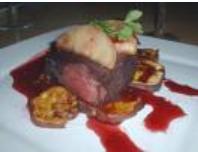
“It’s gamey — think beef plus arm pit,” says Freya Petersen, GlobalPost’s Breaking News Editor and our resident Australian staffer. “It needs to be cooked through but not over-cooked.”
“To me, it smells like pet food because we used to feed it to our dog and cat,” she adds.
Environmentalists and animal rights groups are also worried about the plan.
Australia’s kangaroo population “can’t even deal with the domestic and European consumption,” Nikki Sutterby of the Australian Society for Kangaroos told the New York Times. “How would it deal with a country as large as China starting to eat kangaroo meat?”
The kanga-meat crowd down under, however, remains undeterred.
“I’d expect us to be putting product into China at some time this year,” Kelly told the New York Times, adding that he expected China “at some stage to be a larger market than Russia ever was.”
.
[Source: ‘Would you eat thsi animal?’, by Thomas Mucha, 20110415, ^http://www.globalpost.com/dispatches/globalpost-blogs/macro/kangaroo-australia-china]
.
.
‘It sure ain’t Easy being Green! About the Kangaroo Coalition coordinator!’
by John Watson, Spectator News Magazine
.
‘Pat O’Brien became a greenie, and activist, in Condobolin 35 years ago when he saw kangaroos herded together, shot and clubbed to death. Until that moment, he had been “normal”.
The meatworker, who was working his way around Australia with his wife and three kids, did not think about the environment, probably dropped paper on the ground and just lived his own life. However, because of that sight of kangaroos being slaughtered, he has spent the next 35 years fighting for animals and the environment….’
READ MORE: ^http://www.kangaroo-protection-coalition.com/coordinator.html
.
Meanwhile, the Queensland Government tries to legitimise wildlife poaching by using euphemistic language…’The Department’s Commercial Macropod Management Program administers the commerical harvest of macropods in Queensland.’
.
^http://www.derm.qld.gov.au/wildlife-ecosystems/wildlife/wildlife_permits_and_licences/kangaroo_harvesting.html
‘It’s a poor farm that can’t sustain a few kangaroos.’
.
.
Further Reading:
.
[1] ‘ A Shot in the Dark‘, ^ http://www.wildlifeadvocate.com/pdf/a_shot_in_the_dark.pdf , [ Read Report]
[2] National Kangaroo Protection Coalition, ^ http://www.kangaroo-protection-coalition.com/
[3] THINKK (The Think Tank for Kangaroos), University of Technology Sydney, ^ http://thinkkangaroos.uts.edu.au/
[4] No Kangaroo Meat website, ^ http://www.nokangaroomeat.org/
[5] ‘ Kangaroo Harvesting under the spotlight‘, ABC TV ‘730 Programme’, 20110713, ^ http://www.abc.net.au/7.30/content/2011/s3268904.htm
[6] Australian Society For Kangaroos, ^ http://www.australiansocietyforkangaroos.com/not_so_green.html
[7] Read the original comments to the initial article by Tigerquoll on the CanDoBetter.net website: ‘ Kangaroo rapers of Mitchell (Qld) and the E.coli time bomb‘
.
.
Tags: Anna Bligh, Charleville, E. coli, export for human consumption in fancy restaurant, kanga meat, Kangaroo Industry Association of Australia, kangaroo meat, kangaroo meat hygiene, kangaroo pet food, kangaroo poaching, kangaroo slaughter trade, Mitchell, Queensland, Rolf Harris, roo raper, roo shooter, Russian kangaroo meat, THINKK, Warrego Highway, wildlife poaching
Posted in Kangaroos and Macropods, Threats from Poaching and Poisoning | No Comments »
Add this post to Del.icio.us - Digg
Friday, December 31st, 2010
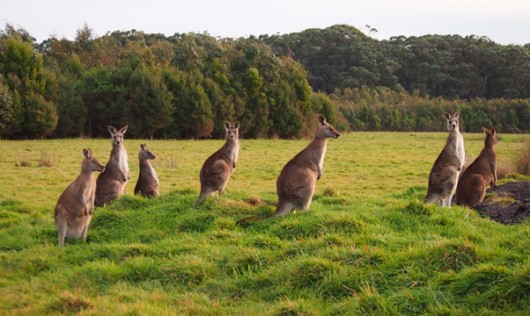 Eastern Grey Kangaroos
(Australian Geographic) Eastern Grey Kangaroos
(Australian Geographic)
.
New Rural Industries Association
.
A new rural organisation in Australia, driving innovative agribusiness ideas, the New Rural Industries Association (NRIA) truly has some good ideas for those on the land. But one of them is certainly not such a good idea – supporting more kangaroo slaughter.
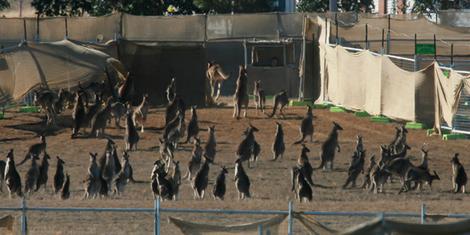 Kangaroos around Canberra herded into pens for the slaughter
.. then butchered for packaging into cat and dog food
Photo by Andrew Taylor
[Source: ^http://www.smh.com.au/news/conservation/welfare-groups-outraged-as-kangaroo-cull-starts/2008/05/19/1211182703329.html]
Kangaroos around Canberra herded into pens for the slaughter
.. then butchered for packaging into cat and dog food
Photo by Andrew Taylor
[Source: ^http://www.smh.com.au/news/conservation/welfare-groups-outraged-as-kangaroo-cull-starts/2008/05/19/1211182703329.html]
.
The NRIA on its new website states that its mission is:
“through cooperation, coordination and education, to create an environment for the development and capacity-building of new, innovative, Australian rural industries and to maximise the economic benefits our nation gains from such industries.”
.
At what ecological cost? At what untold wildlife trauma?
.
It is all very well encouraging those on the land to make a quid and prosper from new emerging agricultural markets, but poaching wildlife is immoral in the mix of available options.
To push for more wildlife trade in Australia, is akin to the logging industry pushing for a new exploitative use of our native forests for ‘biomass’ – burning trees for power! It is no different to the ‘bushmeat’ wildlife trade currently being prosecuted from Africa to Europe.
Reading the NRIA website section under New Animal Industries – ‘Kangaroos and Wallabies‘- the script seems taken drirectly out of a promotion by the Kangaroo Industry Association (KIA). It is peppered with exploitative euphemistic terms like ‘kangaroo industry‘, ‘kangaroo harvesting‘ and ‘pest control‘. All terms deliberately chosen to try to legitimise what is blatantly wildlife poaching.
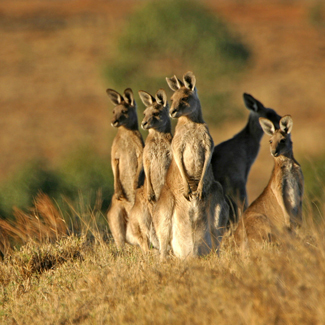
Then it suggests that the poaching is legitimate by claiming there is “a quota system” and that the poaching is “administered by the state and federal governments”.
It then argues that this wildlife trade is highly lucrative, quoting the “kangaroo industry was an estimated $43.9 million in 2007”, with major export markets being Indonesia, New Zealand and Russia. It is trying to sell kangaroo meat overseas beyond what has long been regarded as pet food. It is trying to rebrand the pet food as ‘game meat’ and is having success in Europe, notably recently in France, South Africa and Germany, and in Russia as sausage meat..

.
‘Bushmeat’?
.
Wildlife is wildlife and with so little remaining on so few token reserves, all wildlife deserve humanity’s utmost respect and protection.
Australian wildlife is no less deserving than African wildlife. In Africa, ‘illegal bushmeat is being sold on Paris streets‘ ranging from monkey carcasses, smoked anteater, even preserved porcupine. In Australian, bushmeat is our wildlife – our native kangaroo, wallaby, koalas, platypus, echidna, Tasy devil, wombat, potoroo and many other unique and vulnerable fauna.
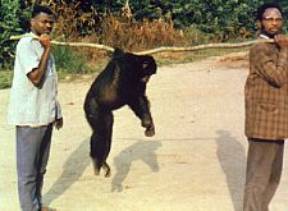 ‘A bonobo, most human-like of the great apes, killed for meat’. ‘A bonobo, most human-like of the great apes, killed for meat’.
© SUSAN MILIUS / Science News 26feb2005
http://www.mindfully.org/Food/2005/Bushmeat-Hunger-Commerce26feb05.htm
.
‘In Paris, a recent study has found more than five tonnes of bushmeat slips through the city’s main airport each week to serve its underground bushmeat market. Experts suspect similar amounts are arriving in other European hubs as well – an illegal trade that is raising concerns about diseases ranging from monkeypox to Ebola, and is another twist in the continent’s struggle to integrate a growing African immigrant population. According to research published in the journal ‘Conservation Letters’,
“Anecdotally we know it does happen … But it is quite surprising the volumes that are coming through,” said Marcus Rowcliffe, a research fellow of the Zoological Society of London and one of the study’s authors.
“Everyone knows bushmeat is sold in the area and they even know where to buy it,” said Hassan Kaouti, a local butcher. “But they won’t say it’s illegal.”
For the study, European experts checked 29 Air France flights from Central and West Africa that landed at Paris’ Roissy-Charles de Gaulle airport over a 17-day stretch in June 2008. Of 134 people searched, nine had bushmeat and 83 had livestock or fish.
The people with bushmeat had the largest amounts: one passenger had 51kg of bushmeat – and no other luggage. Most of the bushmeat was smoked and arrived as dried carcasses. Some animals were identifiable, though scientists boiled the remains of others and reassembled the skeletons to determine the species.
Experts found 11 types of bushmeat including monkeys, large rats, crocodiles, small antelopes and pangolins, or anteaters. Almost 40 per cent were listed on the Convention on International Trade in Endangered Species.
Based on what officials seized – 188kg of bushmeat – the researchers estimated that about five tonnes of bushmeat get into Paris each week.
Bushmeat is widely eaten and sold in Central and West Africa, with Central African Republic, Cameroon and Republic of Congo being the main sources. It varies whether it is legal. It is typically allowed where people are permitted to hunt, as long as their prey aren’t endangered and they can prove the animals were killed in the wild. And just as scientists have warned that eating African bushmeat is a potential health hazard, eating roadkill and wildlife is just at risk of bacterial infections like salmonella and ecoli.
Nina Marano, chief of the quarantine unit at the US Centres for Disease Control and Prevention, said similar underground markets for bushmeat exist across the US. “We have to be culturally sensitive and recognise this is important for some African communities,” she said. “But there are no regulations for the preparation of meat from wildlife to render it safe.”
The scale of Europe’s illicit bushmeat trade suggests the emergence of a luxury market. Prices can be as high as 30 euros ($A43) per kilogram, double what more mundane supermarket meats cost. “It’s like buying the best cut of organically grown beef,” Rowcliffe said, adding that bushmeat like giant rats and porcupine, which he has tasted, has a strong, gamey flavour.’
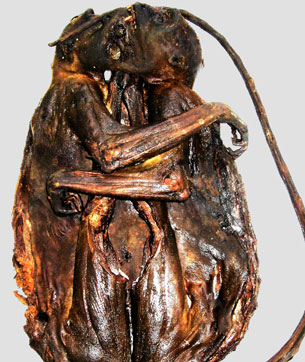 © AP, [Source: ‘Illegal bushmeat sold on Paris streets’, AP, The West Australian,20100618,
http://au.news.yahoo.com/odd/a/-/odd/7419656/illegal-bushmeat-sold-on-paris-streets/] © AP, [Source: ‘Illegal bushmeat sold on Paris streets’, AP, The West Australian,20100618,
http://au.news.yahoo.com/odd/a/-/odd/7419656/illegal-bushmeat-sold-on-paris-streets/]
.
Meanwhile back in Australia, the NRIA claims “commercial harvesting” of wallabies is happening across Tasmania and on Flinders Island and King Island in Bass Strait…”ensuring the sustainability of the harvest“. Shooters are now targeting Tasmania’s beautiful Bennett’s Wallaby (Macropus r. rufogriseus) and the Tasmanian Pademelon (Thylogale billardierii).
.
“More than 9000 wallabies were harvested in 2005-06 but this was much less than the combined quota of 34,750.”
.
[Source: New Rural Industries Australia ^http://www.nria.org.au/NewAnimalIndustries/KangaroosandWallabies.aspx ]
.
Wildlife slaughter and trade is unnecessarily wicked!
.
Why is Australia’s Gillard Government condoning a trade in Australian wildlife?
.
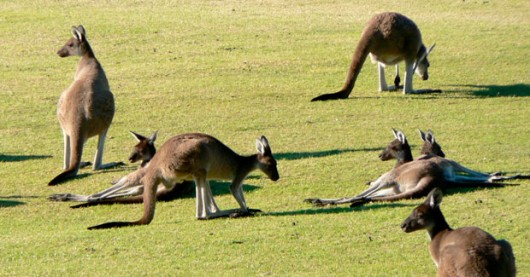 Eastern Grey Kangaroos
Kangaroos are commonly killed to save crops and private property
(Photo by Michael Parsons)
[Source: Australian Geographic magazine, ^http://www.australiangeographic.com.au/journal/dingo-urine-saves-kangaroos-study-says.htm] Eastern Grey Kangaroos
Kangaroos are commonly killed to save crops and private property
(Photo by Michael Parsons)
[Source: Australian Geographic magazine, ^http://www.australiangeographic.com.au/journal/dingo-urine-saves-kangaroos-study-says.htm]
.
.
Further Reading
.
[1] Kangaroo Industry Association of Australia (^http://www.kangaroo-industry.asn.au).
[2] Australian Department of Environment and Water Resources, ^www.environment.gov.au/biodiversity/trade-use/wild-harvest/kangaroo/stats.html, (for information on the kangaroo industry, including quotas and numbers harvested).
[3] New Rural Industries Australia ^http://www.nria.org.au/NewAnimalIndustries/KangaroosandWallabies.aspx ]
[4] ‘Illegal bushmeat sold on Paris streets’, AP, The West Australian, 20100618, ^http://au.news.yahoo.com/odd/a/-/odd/7419656/illegal-bushmeat-sold-on-paris-streets/]
[5] ‘Illegal Bushmeat Trade Rife in Europe, Research Finds’, ScienceDaily (June 18, 2010), ^http://www.sciencedaily.com/releases/2010/06/100617210641.htm
[6] Kangaroo Protection Coalition, ^http://www.kangaroo-protection-coalition.com/canberrakangaroocull.html
[7] AQIS Meat Notice 2010/02 – Microbiological Testing of Wild Game Carcases and Products ^http://www.daff.gov.au/aqis/export/meat/elmer-3/notices/meat_notices_2010/2010-02_microbiological_testing_of_wild_game_carcases_and_products
.
-end of article –
Tags: Bennetts Wallaby, bushmeat, European Commission, European Food Safety Agency, Gillard wildlife trade, Kangaroo Industry Association of Australia, kangaroo poaching, Macropus r. rufogriseus, new rural industries, new rural industries australia, New Rural Industry Association, NRIA, Pademelon, Thylogale billardierii, US ban on imports of kangaroo, wallaby poaching, wildlife poaching
Posted in Threats from Poaching and Poisoning | 1 Comment »
Add this post to Del.icio.us - Digg
|
|
















